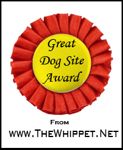

Whippet Dog Photo Contest
Hello and welcome to our November issue of the Whippeteer!Our Whippet Dog Photo Contest has now the picture of Dolly leading with six comments. Add your comments to vote for your favorite picture or share your best whippet pictures with our third Whippet Dog Photo Contest!
It’s easy, just enter here your favorite whippet pictures with a story about your dog and you can win a lovely blue whippet collar.
Dog Poisons in Your Home
During the winter months we spend more time indoor with our dogs but our homes can hide many dangers for the inquisitive mind and noses of our pets.Innocent looking household products and plants can be deadly dog poison. We dedicated this November issue to the dangers that common household items pose to dogs.
Please, read this informative article to protect your dogs.
Poison Awareness
As a fellow dog enthusiast I am sure you are aware that one of the most direct routes to winning a dog's heart is through his stomach. I believe most of you will also agree that dogs use their mouths to investigate the world around them - tasting, chewing and often consuming the interesting things in their environment. While the consumption of some foods, plants, household chemicals, and other seemingly edible objects may seem initially rewarding to our furry friends, they could be poisonous and thus deadly when ingested. Unfortunately, dogs do not have the ability to differentiate between what is safe and what is dangerous for them to eat; thus, thousands of dogs per year unknowingly ingest toxic substances and subsequently poison themselves. In addition, loving dog owners unknowingly provide their pets with poisonous foods as treats (i.e. chocolate) because they lack poison awareness knowledge. This is where you as a professional dog trainer come in. According to the ASPCA Animal Poison Control Center, 130,000 poison related cases were reported and handled just in 2007 alone. With this many occurrences in only one year, it just makes good sense to add poison awareness to your Dog Trainer's Toolbox. Poisonous Substances While the following lists are in no way complete, I have tried to include the most common and most dangerous substances that may be ingested by dogs. Also, be informed that while certain substances are poisonous to dogs and other animals regardless of the amount ingested, other poisonous substances can be tolerated in very small doses based on the amount ingested in relation to the animal's weight. For instance, while chocolate is a widely-known toxin for dogs, a minimal amount of chocolate ingested by a large dog will most likely be filtered through his system without the need for a trip to the veterinarian. Foods - The ASPCA Animal Poison Control Center urges dog owners to avoid feeding the following foods to their pets: alcoholic beverages, avocado, baking powder, baking soda, chocolate, coffee, fatty foods, many fruit pits including those of cherries, peaches, avocados, and apricots, macadamia nuts, moldy or spoiled foods (such as those found in garbage), mushrooms, onions and onion powder, raisins and grapes, salt, yeast dough, garlic, and products containing the artificial sweetener xylitol. Household products - Common household products can be extremely toxic to canines, such as automobile antifreeze, a liquid that can leak from some automobiles. The liquid is green in color and sweet to the taste. The dog only needs to lick a small amount of antifreeze off of the street or driveway to become poisoned. Other poisonous household products include cleaners such as Febreeze odor neutralizer, bleach, abrasive cleaners, cleaning solvents, dish washing detergent, laundry detergent, disinfectants, drain cleaner, furniture polish, paint and paint solvents, and more. Even office supplies such as indelible ink, pencils, and crayons should be kept in a secure place as these too are toxic when ingested. Personal care items such as hair dye and perfume are dangerous as well. Medications - Dog owners should consult a veterinarian before administering any type of medication to their canines, especially those that are meant for human consumption. Ibuprofen (Advil), acetaminophen (Tylenol), cold and flu medications, and antidepressants are especially dangerous and should be kept out of reach of all pets. Illegal drugs, including marijuana, are also among the lists of poisonous substances. Insecticides and Pesticides - These chemicals can be particularly attractive and enticing to dogs because they are commonly mixed with tasty food products to make them alluring to the pests they are meant to kill. Rat bait, snail bait, insecticides, moth repellent, and even some flea products are toxic when ingested by dogs and other animals. Some species of animals are especially sensitive to certain types of flea products, so do not use flea products interchangeably between dogs, cats, and other pets. Always consult a veterinarian first and read all instructions and indications. Common Household Plants - The list of common household plants that are potentially poisonous to canines is extensive. According to the ASPCA, the 17 most common poisonous plants are as follows: lilies, marijuana, sago palm, tulip/narcissus bulbs, azalea/rhododendron, oleanders, castor bean, cyclamen, kalanchoe, yew, amaryllis, autumn crocus, chrysanthemum, English ivy, peace lilies, pothos, and schefflera. Some other common plants seen in many landscapes that may also be toxic to dogs are aloe vera, birds of paradise, daffodils, honeysuckle, poppies, geraniums, marigolds, oleanders, tomato plants, and many, many more. Seasonal decorative plants such as poinsettias, mistletoe, and Easter lilies should be kept out of reach of all pets. Even fertilizer is considered hazardous if ingested. Signs, Symptoms, and Prevention One of the most important aspects of poison awareness is realizing that not all dogs will display external signs of toxin ingestion prior to organ failure and death. Thus, all dog owners should be urged to secure any and all items that are toxic or even potentially toxic. Even dogs who are under constant supervision can find a quick moment to lap up a tasty but toxic snack, so prevention is crucial. Safety measures include keeping all food and household chemicals/cleaners in cabinets that are too high for a dog to reach or child-proofing cabinets that are within reach, securing trash cans or taking the trash out regularly, especially before leaving the dog unattended in the house, and landscaping appropriately by removing or ruling out any plants that are known as being poisonous to dogs from your garden. Symptoms of poisoning vary, but may include vomiting, seizures, difficulty breathing, diarrhea, skin allergies, nasal discharge, eye discharge, drooling, lethargy, shaking, weaving, or stumbling. If an owner observes any of these symptoms and supposes that the dog may have come into contact with a poison, he/she should contact a veterinarian immediately. Serious symptoms such as seizures call for an emergency trip to the veterinarian, though the veterinarian should be alerted via phone prior to the dog's arrival. The owners should also bring along a sample of the potentially ingested substance or the container in which it was held, if at all possible. The owner should also be advised to contact the ASPCA Animal Poison Control Center hotline at (888) 426-4435. The ASPCA may be able to offer advice that can be followed in order to limit or prevent damage to your pet from poisonous substances. I hope you find this information useful and readily pass it along to all your clients and fellow dog lovers. Debbie Kendrick is the Vice President and COO of Animal Behavior College. She has been a key component in the company since they opened their doors in 1998. She is a devoted animal lover with over two decades of professional experience in the animal industry. Animal Behavior College is a private vocational school specializing in animal-related career training. http://www.AnimalBehaviorCollegeCourses.com Article Source: https://EzineArticles.com/?expert=Debbie_Kendrick
Visit the TheWhippet.net frequently as we are constantly updating our site with information, resources and tips for the dog lover. I would like to thank here all our readers whether they are regular visitors or new to the site and especially all the contributors to our pages. They all made my job more rewarding and our site more interesting for everyone.
All your contributions are really appreciated! Visit us soon at TheWhippet.net! |
Win a Whippet Collar!

Enter our Whippet Dog Photo Contest to win this lovely whippet collar. Click here to find out more!
Read our interview with Bo Bengtson, acclaimed author of the most important and beautiful book about the whippet breed.
Can't find the page you are looking for? Type a word in the space below, click the search button and find it in our site!

Do You Have a Dog Related Website?

Would you like to show the "Great Dog Site Award" badge on your dog related site? Cick here to find out how!

